The Perfect Locating Signed Roman Domination of some Graphs
 Download PDF
Download PDF
Authors: A. D. AKWU, T. C. ADEFOKUN AND O. OYEWUMI
DOI: 10.46793/KgJMat2602.175A
Abstract:
In this paper, we introduce the concept of Perfect locating signed Roman dominating functions in graphs. A perfect locating signed Roman dominating PLSRD function of a graph G = (V,E) is a function f : V (G) →{−1, 1, 2} satisfying the conditions that for (i) every vertex v with f(v) = −1 is adjacent to exactly one vertex u with f(u) = 2; (ii) any pair of distinct vertices v,w with f(v) = f(w) = −1 does not have a common neighbor u with f(u) = 2 and (iii) f(v) + ∑ u∈N(v)f(u) ≥ 1 for any vertex v. The weight of PLSRD- function is the sum of its function values over all the vertices. The perfect locating signed Roman domination number of G denoted by γLSRP(G) is the minimum weight of a PLSRD- function in G. We present the upper and lower bonds of PLSRD- function for trees. In addition, for grid graph G, we show that γLSRP(G) ≤
 |G|.
|G|.
Keywords:
Perfect Roman domination, locating Roman domination, signed Roman domination, Cartesian product graph.
References:
[1] B. Al Subaiei, A. Almulhim and A. D. Akwu, Vertex-edge perfect Roman domination number, AIMS Mathematics 8(9) 2023, 21472–21483. http://www.aimspress.com/journal/Math
[2] M. Blidia, M. Chellali, F. Maffray, J. Moncel and A. Semri, Locating-domination and identifying codes in trees, Australas. J. Combin. 39 2007, 219–232.
[3] M. Blidia, O. Favaron and R. Lounes, Locating 2-domination and idependence in trees, Australas. J. Combin. 42 (2008), 309–319.
[4] X. G. Chen and M. Y. Soh, Bounds on the locating total-domination number of a tree, Discrete Appl. Math. 159 2011, 769–773.
[5] M. Chellali, On locating and differentiating total domination in trees, Discuss. Math. Graph Theory 28 (2008), 383–392. https://doi:10.7151/dmgt.1414
[6] M. Chellali and N. Jafari Rad, Locating total-domination critical graphs, Australas. J. Combin. 45 (2009), 227–234.
[7] M. Chellai, N. Jafari Rad, S. M. Sheikholeslami and L. Volkmann, Structures of domination in graphs, in: T. W. Haynes, S. T. Hedetniemi and M. A. Henning (Eds.), Varieties of Roman domination, Spinger, 2020.
[8] M. Chellai, N. Jafari Rad, S. M. Sheikholeslami and L. Volkmann, Topics in domination in graphs, in: T. W. Haynes, S. T. Hedetniemi and M. A. Henning (Eds.), Roman Domination in Graphs, Spinger, 2020.
[9] E. J. Cockayne, P. A. Dreyer Jr, S. M. Hedetniemi and S. T. Hedetniemi, Roman domination in graphs, Discrete Math. 278 (2004), 11–22.
[10] M. Henning, W. Klostermeyer and G. MacGillivray, Perfect Roman domination in trees, Discrete Appl. Math. 236 (2018), 235–245.
[11] N. Jafari Rad and H. Rahbani, Bounds on the locating Roman domination number in trees, Discuss. Math. Graph Theory 38 (2018), 49–62.
[12] K. Kim, Perfect Roman domination in middle graphs, Discrete Math. Lett. 7 (2021), 94–97.
[13] L. M. Paleta and F. P. Jamil, More on perfect Roman domination in graphs, Eur. J. Pure Appl. Math. 13(3) 2020, 529–548.
[14] C. S. ReVelle and K. E. Rosing, Defendens Imperium Romanum: a classical problem in military, Amer. Math. Monthly 107(7) 2000, 585–594.
[15] P. J. Slater, Dominating and location in acyclic graphs, Networks 17 (1987), 55–64.
[16] P. J. Slater, Dominating and reference sets in graphs, J. Math. Phys. Sci. 22 (1988), 445–455.
[17] I. Stewart, Defend the Roman empire!, Scientific American 281(6) (1999), 136–138.
[18] J. Yue and J. Song, Note on the perfect Roman domination of graphs, Appl. Math. Comput. 364 (2020), 1–5.
